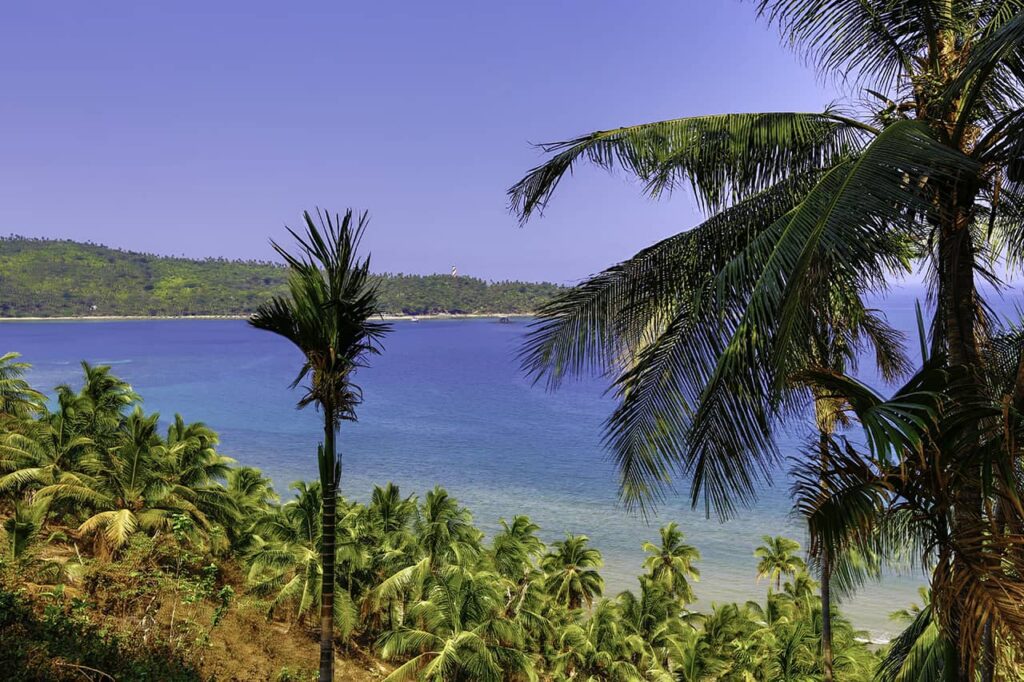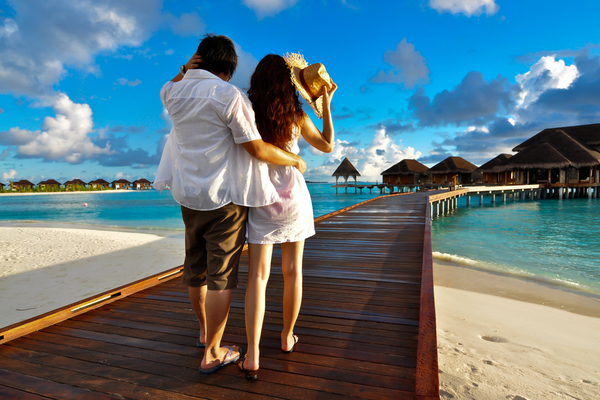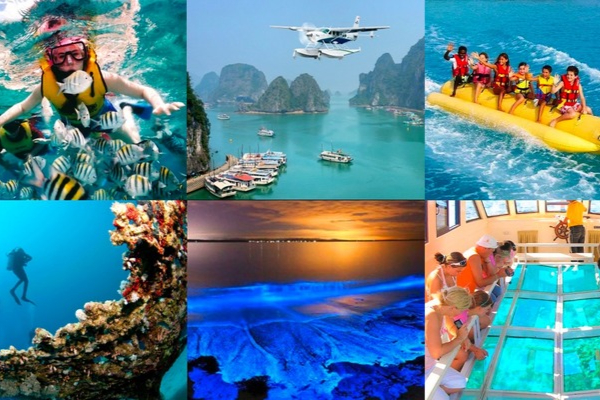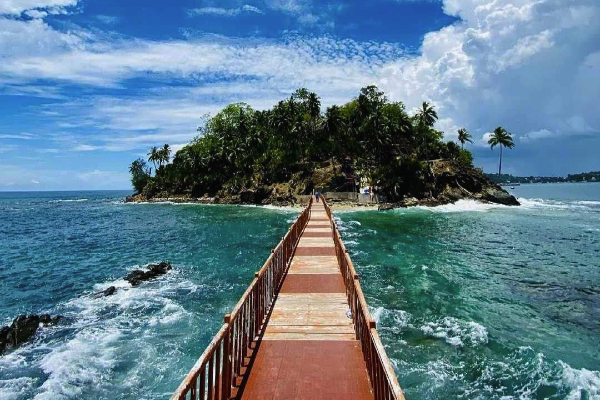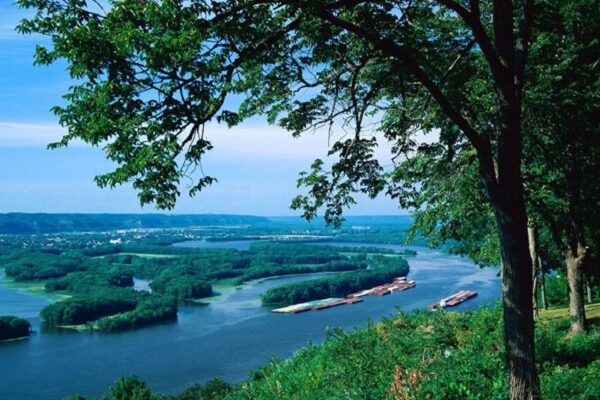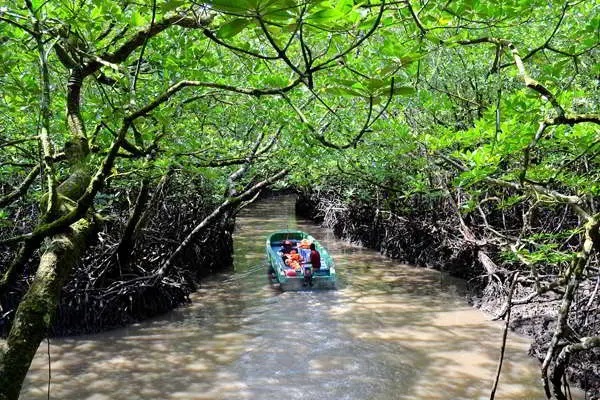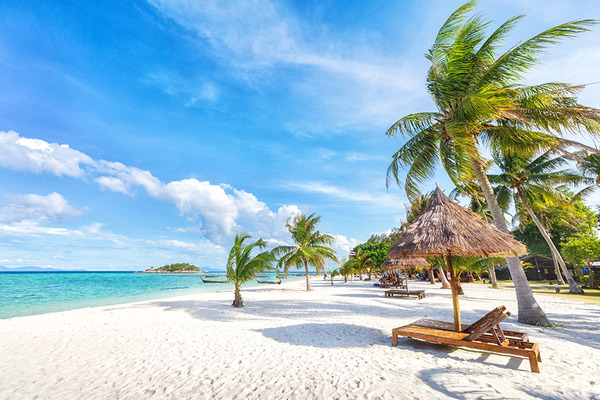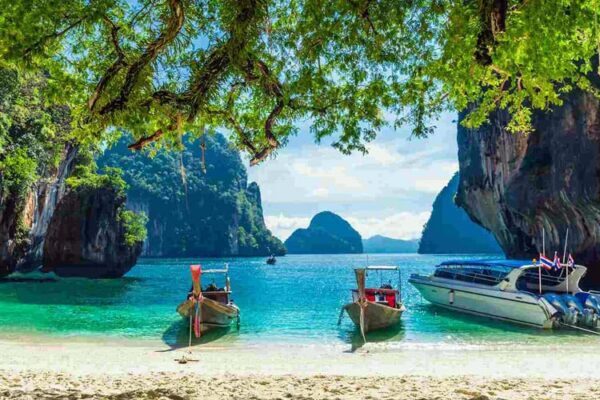
Andaman And Nicobar Islands
The Andaman and Nicobar Islands are a Union territory of India comprising 572 islands,islets and rocks, out of which 38 are inhabited. Located at the meeting point of the Bay of Bengal and the Andaman Sea, the territory lies about 1,000 miles southeast of the Indian mainland and covers an area of around 8,249 square kilometers. The capital and the largest city of the territory is Port Blair. Administratively, the islands are divided into three districts: Nicobar District with Car Nicobar as capital, South Andaman district with Port Blair as capital and North and Middle Andaman district with Mayabunder as capital.
The name of the islands have intriguing origins. The word “Andaman” is believed to derive from “Handuman”, the Malays form of the Hindu God Hanuman from the epic Ramayana. On the other hand, “Nicobar” is said to come from the Tamil word “Nakkavaram” which means “Open/Naked land”. Hindi and English are the official languages, but Bengali, Tamil, Telugu, Malayalam, and Nicobarese are also widely spoken.
The Andaman and Nicobar Islands possess a rich history, with references found in ancient texts. The indigenous Andamanese are believed to have remained isolated since the Middle Paleolithic era over 30,000 years ago, while archaeological evidence shows civilization from about 2,200 years ago. In the 11th century, the Chola dynasty used the islands as a naval base for their Southeast Asian campaigns. The Danish were the first Europeans to arrive in 1755, followed by British control in 1868. During World War II, the Japanese occupied the islands. After India gained independence in 1947, the islands became part of the nation in 1950 and were formally declared a Union Territory in 1956.
Culturally, the islands reflect a fusion of Indian traditions and the customs of the indigenous tribal communities. The traditional dress of the Islands varies across communities. The Indigenous tribes such as Great Andamanese, Onge, and Jarwa traditionally wore very little clothing, often using leaves, bark fibers, and ornaments made of shells, bones, and wood. The Nicobarese tribe wore coconut-leaf outfits and later adopted sarongs, skirts and shirts. Settlers and the urban population, however, wear regular Indian attire, with tribal costumes mostly seen during cultural festivals and events.
Dance and music play a vital role in the cultural life of the islands. The Nicobarese Dance, commonly performed during festivals and weddings, is a well-known folk tradition accompanied by tribal songs and drum beats. The music blends tribal rhythms with influences from settlers, creating a vibrant mix of folk, devotional, and modern styles.The cuisine of the islands highlights their coastal lifestyle, with seafood as the main staple. Dishes like fish curry, coconut-based curries, and preparations of lobsters, crabs, and prawns are popular, along with tropical fruits such as pineapple and banana. The region is also rich in art and craft, with locals creating wooden carvings, shell jewelry, cane and bamboo products, and handicrafts made from coconut.
The islands celebrate the Island Tourism Festival, the biggest event held in January at Port Blair highlighting local culture, music, dance, and crafts. Other notable festivals include the Subhash Mela in Havelock, the Beach Festival, and the traditional Ossuary Feast of the Nicobarese tribe. Along with these, popular Indian festivals such as Diwali, Eid, Christmas, and Pongal are observed with equal zeal and joy.
The territory also has its own symbols: the Dugong as the state animal, the Andaman wood pigeon as the state bird, and Pyinma as the state flower.
The Andaman and Nicobar Islands are famed for their pristine beaches, turquoise waters, tropical forests, and diverse marine life. Popular attractions include Radhanagar Beach, Cellular Jail, Ross Island, Baratang’s limestone caves, and Mahatma Gandhi Marine National Park. The region also offers adventure sports like scuba diving, snorkeling, sea walking, and trekking. The islands also offer glimpses of rich tribal culture and colonial history, making them a perfect mix of natural beauty and heritage. Nicobar Islands (The southern group) are mostly inaccessible to tourists.
Indian tourists don’t need a permit except for tribal areas, which require special permission from the Deputy Commissioner in Port Blair. Foreign nationals, however, need permits, which are issued on arrival at Port Blair for those traveling by air.
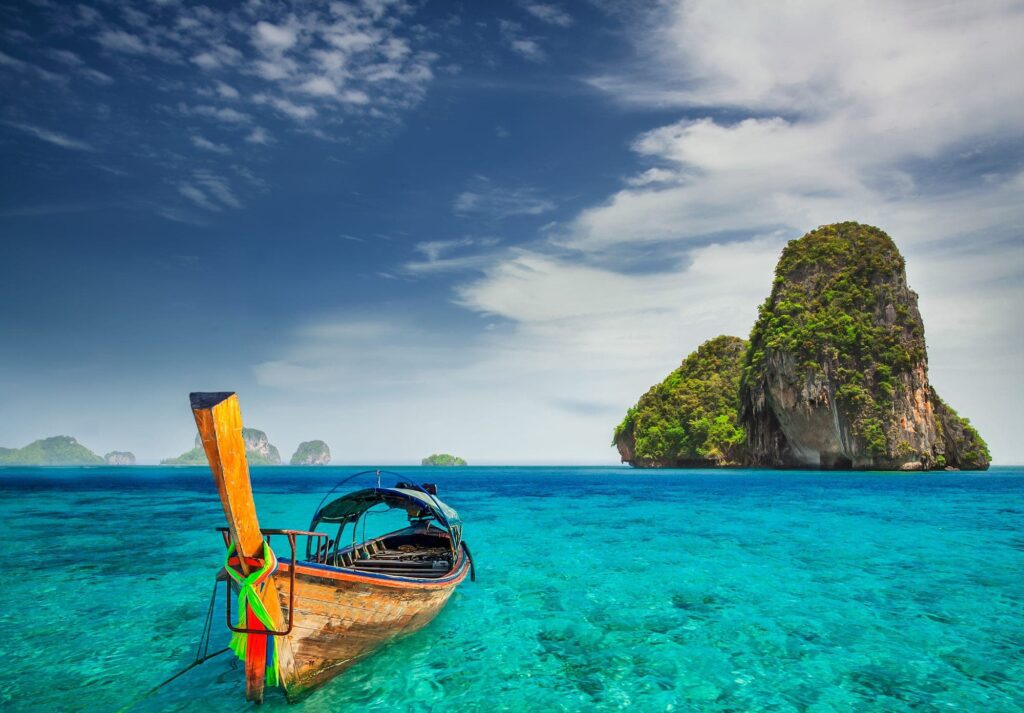

| 1. Port Blair | |
| Port Blair Is The Capital City Of The Andaman And Nicobar Islands And Is The Union Territory Of India Which Is Located In The Bay Of Bengal. Some Of The Attractions Of The Place Are: | |
|
|
|
|
|
|
|
|
|
|
|
|
|
|
|
|
2. Neil Island
 A Small Yet Fascinating Island With Virgin Coral Reefs, Attractive Bio-Diversity, White Sand Beaches, Forest And Vegetation. Some Of The Main Attractions Of The Island Are:
A Small Yet Fascinating Island With Virgin Coral Reefs, Attractive Bio-Diversity, White Sand Beaches, Forest And Vegetation. Some Of The Main Attractions Of The Island Are:
- Bharatpur Beach
- Sitapur Beach
- Laxmanpur Beach
| 3. Diglipur | |
| Diglipur Is The Largest Town In North Andaman And An Eco-Friendly Tourist Destination. Some Of The Attractions Of The Island Are: | |
|
|
|
|
| |
4. Havelock Island
 Havelock Is One Of The Largest In Andaman Nicobar Islands With A Chain Of Island Connected To It. The Place Is A Paradise With A Number Of Fascinating White Sand Beaches, Coral Reefs And Rich Green Forests. Some Of The Main Attractions Of The Place Are:
Havelock Is One Of The Largest In Andaman Nicobar Islands With A Chain Of Island Connected To It. The Place Is A Paradise With A Number Of Fascinating White Sand Beaches, Coral Reefs And Rich Green Forests. Some Of The Main Attractions Of The Place Are:
- Elephant Beach
- Radhanagar Beach
- Kala Pathar Beach
- Vijaynagar Beach
| 5. Rangat | |
| Rangat Is A Town On The Middle Andaman Island And Has Several Turtle Nesting Grounds, Evergreen Waterfalls And A Very Unique Presentation Of The Diverse Mangrove Ecosystem Along With A Nature Walk. Some Of The Main Attractions Of The Island Are: | |
| |
| |
6. Mayabunder
 Mayabunder Is A Town In The Northern Part Of Middle Andaman Island And A Sea Turtle Nesting Ground, Mangrove Lined Tidal Creeks, The 2nd Biggest Harbor After Port Blair- Where The Mainland Passenger Ships Takes Halt. Some Of The Main Attractions Of The Island Are:
Mayabunder Is A Town In The Northern Part Of Middle Andaman Island And A Sea Turtle Nesting Ground, Mangrove Lined Tidal Creeks, The 2nd Biggest Harbor After Port Blair- Where The Mainland Passenger Ships Takes Halt. Some Of The Main Attractions Of The Island Are:
- Karmatang Beach.
The destination has an enormous range of things that tourists can experience and explore on tour to Andaman and Nicobar Islands. It is a small wonderland that has something for everyone.
- Go to the Beaches and enjoy and relax
- Indulge in Water Sports / Activities:-
Snorkeling |
Parasailing |
Sea Walk |
Jet Skiing |
Dolphin Boat Ride |
Glass Bottom Boat Ride |
Kayaking |
Scuba Diving |
Seakart |
Banana Ride |
Speed Boating |
Coral Safari Semi Submarine |
Fishing or Angling |
- Adventure Activities:-
Trekking |
Biking / Cycling |
Seaplane ride |
- Cultural and Religious Experience:-
Visit the temples and churches |
Experience Vibrant local festivals |
- Experience TSG BellaBay’s luxury dinner cruise
- Dolphin Watching Tour
- Explore the famous Cellular Jail and experience Light Show
- Experience a Scenic Helicopter Ride
- Explore Museums and National Parks
- Explore the Limestone Caves of Baratang Island
- Volcano Expeditions: Barren Island & Diglipur
- Leisure Activities:-
Go on a Shopping Spree |
Visit Rubber Plantation |
Enjoy Sunset at Chidiya Tapu |
Andaman can be accessed by two ways only.
By Air
The most comfortable and time-saving mode of transportation to Andaman is only by flight. There are daily flights from Kolkata, Bangalore and Chennai and scheduled flights from Visakhapatnam flying about thrice a week to Andaman’s capital Port Blair. Travelers will have to reach these cities before arriving in Portblair. The Airlines like Spice Jet, Air India, Vistara, Jet Airways, IndiGo, and GoAir serve Veer Savarkar International airport in Port Blair and take approximately 02:00 Hrs to reach Port Blair.
By Sea
Travellers who love long journeys must definitely opt for waterways as there are well-connected travel routes in Andaman Island. It’s a time-consuming journey but the views that one get are worth all the effort. Travelers will have to book at least a month in advance from designated offices and the range of tickets starts from two to ten thousand INR depending on the class of cabin book. Travellers will have to reach Chennai or Vishakhapatnam or Kolkata to avail the Ship services. It will take approximately 50-70 hours to reach Port Blair. Also, weather and sea conditions are important factors in travel and they can add to the time taken to reach Port Blair. Travellers who are seasick can choose a cruise voyage on their return journey.
The Andaman and Nicobar has numerous modes of transport to go to attractions that travellers can choose as per their Budget, preference and convenience.
Air :
Inter-Island travel is not possible by sea planes at the moment. However, there is an inter Island helicopter service which is reserved for VIPs. Travellers can apply at the Directorate of the Civil Aviation office at the helipad one day in advance to use this service. There is a 5 kg baggage limit and the ticket can be quite expensive.
Ferry
Inter-Island travel by ferry is the most popular way to travel. However, this can be quite chaotic as the service is slow and there are long queues for buying tickets. Government ferry tickets can be bought a couple of days before the traveller’s actual journey. If this is too troublesome for travellers, then travellers can ask their travel agent to book the ferry tickets also.
There are frequent boat services from Port Blair to the other islands such as Havelock Island, Neil Islands, Long Island, Mayabunder and Diglipur. There are also private ferry companies which are more expensive but their tickets are available a month in advance. The popular companies that run private ferry services are Green Ocean and Makruzz.
Buses
Mohanpura bus terminus is the central terminus. Buses are available throughout the day. The South, Middle and North Andaman group are connected by road and there are ferry crossings and bridges as well, which makes it possible to travel by bus. Bus services are available from Port Blair to various places such as Wandoor, Baratang, Chidiya Tapu, Rangat, Mayabunder and Diglipur. Havelock has bus services.
Rental
It is possible to hire a car with a driver to travel from Port Blair to Diglipur but a round trip can be quite expensive. However, the drivers are knowledgeable about the best places to visit in Andaman Nicobar and will take travelers there without any hassle. The cars are also neat and clean, and the entire experience is quite satisfactory.
There are also self-drive car rentals which will help travelers experience the Andaman in a rather unique way. However, typical self-drive car rentals come with additional tax and fuel expenses.
(Note: Mobile Network coverage in several key attractions in Port Blair tends to be quite spotty and travelers may get lost and not know how to reach out for help.)
Auto/Tuk-Tuk
There are autos or tuk-tuks but they are not very comfortable as the roads can be bumpy. They are a cheaper way of getting around instead of hiring cabs though.
Cabs/Taxis
Travelers can get taxis or cabs to travel from one place to another place. These are slightly more expensive than the autos.
(Note: There’s no Uber or Ola in Andaman.)
Motorcycles or Bicycles
Travelers can hire motorcycles or bicycles from Port Blair to go around the island. These can be hired for a whole day and are quite economical. Motorcycle charges are around INR 500 per day (Minimum) while bicycles charges can be around INR 300 at the most.
TOUR PACKAGES OF ANDAMAN AND NICOBAR ISLANDS
- 06 Day(s) 05 Night(s)
- 06 Day(s) 05 Night(s)
- 08 Day(s) 07 Night(s)
- 07 Day(s) 06 Night(s)
- 05 Day(s) 04 Night(s)
- 05 Day(s) 04 Night(s)
Inclusions:-
- Assistance on Arrival.
- Accommodation on double-sharing basis with breakfast.
- Lunch and dinner are also provided based on guests requirements.
- The vehicle is available strictly as per the itinerary and not at disposal.
- All entry permits, entry tickets included to all sightseeing points, inter island ferry tickets (subject to technical/weather conditions), and forest area permits wherever applicable.
- All parking fees, road taxes, toll charges etc.
- Complimentary stay for children below 5 years.
- Dedicated assistance from an Andaman travel expert on all islands.
- For Honeymooners:
- One flower decoration and special honeymoon cake on the day of arrival.
- Candlelight dinner at Havelock Island.
- Evening luxury dinner cruise on TSG Bella Bay.
Exclusions:-
- Additional excursions, sightseeing or extra usage of vehicles beyond the itinerary.
- Expenses arising due to circumstances beyond our control, such as bad weather, natural calamities (landslides, floods), flight delays, excess baggage, rescheduling or cancellations, accidents, medical emergencies, riots, strikes, war, or changes in airline/hotel policies.
- Any increase in taxes or fuel cost resulting in higher transportation and land arrangements charges, which may come into effect prior to departure.
- Tour guide services at any sightseeing place.
- All Water sport activities like Snorkeling, Scuba diving, Glass Bottom ride, Sea Walking Etc…
- Any services not specifically listed under inclusions.
- Camera Tickets are NOT INCLUDED in the mentioned cost of Sightseeing & Transfers.
- Any portage at airports and hotels, tips, Visa, insurance, Alcoholic and non alcoholic beverages, mineral water, telephone charges and all items of personal nature.
- Compulsory Gala Dinner charges on Christmas & New year Eve if applicable.
- Credit card payment surcharge.
- Peak season supplements and additional charges.
- All applicable government taxes.
Note: Inclusion and Exclusion of Customized Trips will be provided on request.
- For Indian Nationals: Travel to the Andaman and Nicobar Islands is treated the same as domestic travel within India. Indian citizens do not require a passport, visa, or any special permit to visit. Visitors are free to stay in the designated areas for any duration of their choice.
- For Foreign Nationals: Foreign travelers are required to carry a valid passport along with an Indian visa to enter the Andaman and Nicobar Islands. The Restricted Area Permit (RAP) has been waived for most nationalities; however, citizens of Afghanistan, Myanmar, China, and Pakistan are still required to obtain the permit prior to entry.
- To avoid last time disappointment booking tickets, accommodation and activities well in advance. Especially during peak season when most flights run full and the price of flights, accommodation and activities get high. It is also necessary to re-confirm flight timings at least 24 hours before departure.
- The list of essential things and must carry items while travelling to Andaman and Nicobar Islands are –
- Clothing and attire:
- Cotton clothes outfits like sarongs, sundresses, shorts, and light shirts
- Smart casual outfits for romantic dinners or special outings.
- Swimwear
- Comfortable footwear
- Rain protection
- Sun and Skin Protection:
- Sunscreen
- Sunglasses
- Hat
- Insect repellent
- Personal Skincare & Face Wash
- Health and hygiene essentials:
- Medication and first aid kit
- Toothbrush & Toothpaste
- Razor & Shaving Cream
- Deodorant
- Toilet paper and travel wipes
- Hand Sanitizer
- Gadgets & Accessories:
- Camera
- Power bank
- Chargers
- Extra memory Cards and batteries
- Waterproof cases.
- Reusable Water Bottle
- Beach mat/ Hammock
- Pocket diary and Pen
- Cellular jail is closed on every Monday and national Holidays, visit to Cellular jail and Museum closes by 16:00 hrs and light n sound show is open every day 18:00 hrs.
- Baratang Island is closed every Monday.
- Jolly Buoy Island is mostly closed on Mondays and would remain open only for 6 months in 12.
- Ross Island is closed every Wednesday.
- Check-in time at the hotel is 12:00 Noon and check-out is at 8:00 AM.
- Additional accommodation charges due to cancellation of Ferry operation because of bad weather has to be paid by the client directly.
- Breakfast, Lunch & Dinner in most hotels are on A’La Carte/fixed menu, buffet would be subject to availability.
- Any dispute regarding the child age to be settled directly with the hotels.
- Please note, there is no Credit Card & ATM facility at Havelock, Neil Island, Diglipur & Rangat. Kindly carry cash to settle your extra bills.
- No refund of ferry tickets.
- In case private ferry tickets are not available due to sold out dates or cancellation of ferry by Private Ferry operator, then government ferry tickets would be issued.
- It has been found that the ferry timings are changed at a very short notice by the ferry operator, Request the client to abide by it. The tour operator has no role in that.
- Depart from the hotel at 5:30 AM when going to Havelock by Green Ocean Cruise.
- Depart from the Hotel at 4:00 AM for Baratang Island, visiting Lime stone cave and mud volcanoes.
- Ferry timing from Port Blair to Havelock by Green Ocean Cruise is 6:45 AM, Please request hotel for packed breakfast.
- Higher category of cruise tickets would attract supplement charges.
- The Details of Water sports activities are being held on which beach complex:-
| Name of Activities | Held on |
| Scuba Diving | Havelock Island, North Bay Island, Neil Island, Port Blair |
| Parasailing | Elephant beach in Havelock and North Bay and Corbyn’s Cove beach in Port Blair |
| UnderSea Walk | Elephant beach in Havelock |
| Snorkeling | Havelock, North Bay, Jolly Buoy, Neil Island, Red Skin IslandNorth Bay, Neil Island and JollyBouy |
| Jet- Skiing | Rajiv Gandhi Water Sports Complex |
| Glass Bottom Boat Ride | Rajiv Gandhi Water Sports Complex and North Bay Island |
| Banana Ride | Havelock Island and Rajiv Gandhi Water sports complex |
| Kayaking | Havelock Island |
| Seakart | Corbyn’s Cove Beach in Port Blair |
| Speed Boating | Rajiv Gandhi Water Sports Complex |
| Spot Fishing or Angling | Havelock Island and Port Blair |
| Seaplane RIde | Portblair |
- Please carry sufficient clothes for water sports activities at Havelock & North bay Island.
Q: Which is the best time to visit Andaman Island?
Situated in the Bay of Bengal, the islands experience a tropical climate. Andaman is a Year- round Destination, where fluctuations in temperatures are minimal and stay pleasant throughout. To enjoy the beauty of Andaman, summer and winter seasons are the best time as the weather is pleasant, just perfect for sightseeing, beach excursion and water activities like scuba diving, snorkeling, sea walking, etc. Monsoon is not recommended due to high tidal waves, strong winds and incessant rains, and during this season, the water activities are halted too.
| Travel Months | Min/Max Temperature | Season |
| April to June | 24°c – 37°c | Summer |
| July to September | 22°c – 35°c | Monsoon |
| October to March | 20°c – 30°c | Winter |
Q: What are the best places to visit in Andaman and Nicobar islands?
The most visited destinations are Port Blair, Havelock Island (Swaraj Dweep), and Neil Island (Shaheed Dweep), while attractions such as Baratang Island with its natural wonders and the historic Ross Island add further charm to the archipelago.
Q: How many days are sufficient for visiting Andaman?
Ideally, a duration of 5 to 7days is sufficient for covering the major islands of the Andaman. If anyone wishes to see all the famous tourists’ places such as Port Blair, Ross Island, North Bay, Neil Island, Havelock Island, and Baratang Island, then stay more than 8 days here.
Q: What is the currency of Andaman?
The Indian rupee is the currency of Andaman. Travellers can exchange currency at the airport, from the banks or currency dealers. Also, they can withdraw Indian Rupees from the ATMs there.
Q: Whether a Passport/Visa is required to visit Andaman?
- For Indian Tourists: Traveling to the Andaman Islands is just like visiting any other state in India. No passport, visa, or special permission is needed, and you can stay in the permitted areas for as long as you like.
- For Foreign Tourists: A valid passport and Indian visa are required. The Restricted Area Permit (RAP) is no longer necessary for most foreign nationals, except for citizens of Afghanistan, Myanmar, China, and Pakistan, who still need to obtain it. They can be availed on arrival to PortBlair from the Immigration counter at the airport or, embarkation of ships at the sea-port. RAP is issued for a 30 day visit to the islands, and is extendable up to 15 more days. Tickets can be rescheduled in Port Blair itself from the respective airline offices.
Q: What is a RAP?
Under the Foreigners (Restricted) Areas Order, 1963, the entire union territory of Andaman and Nicobar has been declared as a ‘restricted area’. Every foreigner, except a citizen of Bhutan, who desires to enter and stay in a Protected or Restricted Area, is required to obtain a special permit from a competent authority, known as RAP or Restricted area permit. The Restricted Area Permit (RAP) is easily obtained on arrival at Port Blair. The procedure usually takes 15 minutes, is free of cost and is available to all foreign nationals.
Some Indian Visas issued carry a stamp that reads “Entry to restricted areas NOT permitted”. Should a traveller Visa carry such a stamp, please contact the embassy and have the visa re-issued as traveller will not be allowed to enter the Andaman Islands.
Q: How can they extend their visa in Andaman?
Most foreigners arriving at Port Blair are given a 30 day permit. Closer to the time of expiry (about 3 days ahead) this permit can be extended by another 15 days. This extension can be done either at the police station on Havelock or at the Immigration Office in Port Blair, and traveller will need to show a confirmed return ticket (for the journey within the next 15 days) in order to get this extension. Please note that it may not always be possible to get this extension in a few hours. Traveller may need to stay overnight to obtain the extension if they are applying in Port Blair.
Q: Is Andaman safe to travel?
Andaman and Nicobar Islands is gradually becoming a favourite destination among global tourists. The number of tourists is increasing year on year and along with that security challenges are also increasing. The safety factors are being ramped up by the administration to manage the safety and security of the guests visiting the islands. Most of the islands are uninhabited and there are restrictions in travelling to several islands as they are under the protection of the Indian Government and trespassing is strictly forbidden. The roads are safe. Some regions are inhabited by rare and ferocious primitive tribes and rules and regulations are to be followed while travelling through Andaman.
Q: Is it permissible to photograph the indigenous tribal people of Islands?
The tribes of the Islands cherish their peace and any kind of photography of them is strictly prohibited and even punishable.
Q: Is vegetarian food available in Andaman?
Although the Island is not known for its vegetarian cuisine but with the inflow of tourists in Andaman, vegetarian food has become easily available. Almost all restaurants here serve veg food. There are a few pure vegetarian restaurants as well. Some of the well known pure veg restaurants are “Annapurna”, “Icy spicy” and “Punjabi Dhaba” in Port Blair and “Shakahaar” in Havelock.
Q: Is imported alcohol available on the Islands?
Yes, alcohol is available in Andaman and Nicobar islands; availability of imported alcohol is extremely limited. Except for a few Indian Made Foreign Liquor bottles, the alcohol availability is restricted to mostly Indian brands. Some of the brands that are available easily are Black Label, Black & White, Bacardi, Smirnoff and Kingfisher beer. Traveller will also find alcohol being served at various high-end restaurants and bars in Andaman. However, there are certain restrictions in place in a few parts of the state regarding consuming, buying, and selling alcohol.
Q: How expensive are meals in Andaman?
The price of a meal depends entirely on where you eat and what you order. A nice quaint restaurant will cost you between Rs.300 to Rs.500 per person depending on what is ordered. Eating at the local village market will be much cheaper and most islands have a number of small eateries run by locals that work out easy on the pocket.
Sea food is more expensive in the Andamans compared to the mainland due to heavy demand and less supply.
Q: Is there any nightlife in Andaman?
The night life concept has not really been found on these islands, although many Hotels/ Resorts in Port Blair as well as at Havelock hotels/ resorts offer an ambience of bar. Travellers will not encounter loud music, disco lights, DJ’s or other parties here on a regular basis. Nights are usually quiet.
An exception however is during Christmas and New Year on popular islands like Havelock and Neil where travellers will find late parties at night, loud music and a lot of dancing.
Q: What can travellers buy from Andaman and from where?
Andaman is very famous for its exquisite pearls and offers a wide range of sea shell products and exquisite handcrafted souvenirs. For souvenirs and gifts for your family members or close friends, traveller can buy exquisite handcrafted items, Spices, Fishbone Articles, Timber Crafts, Shells, Jute Items, Coconut Handicrafts, Nicobari Mats, Sarongs and Hats, and Cane Goods.
The most famous market of Andaman is the Aberdeen Bazaar in Port Blair from where traveller can buy all above items and also daily essentials including fruits and vegetables.
Q: What to do in case of a medical emergency?
Although, if traveller have been taking any routine medicine for some kind of disease, then it is advised to bring the complete dose of medicine along with him/her. Besides this most Islands have a Primary Health Centre (PHC). It is advisable to go to the nearest PHC first for immediate assistance and as soon as possible, move to the G.B Pant hospital in Port Blair which is better equipped. However at this hospital too, the treatment facilities are not what can be expected in mainland India and for any condition that could be serious, life threatening or needing special care, it is advised to fly to mainland India.
Q: Are there any dangerous animals in Andaman?
As such there are no dangerous predatory animals in the forests of the Andaman. So do not come here expecting to see tigers or lions. The forests here are inhabited by animals like wild boar, spotted deer, civet cat as well as numerous species of birds and butterflies. The vast forest canopy provides home to many different species of reptiles as well. Snakes both poisonous and harmless can be seen in the Andaman. Monitor lizards inhabit these islands and the mangrove creeks provide shelter to ‘salties’ or salt water crocodiles.
Tourists are advised to pay attention to sign boards posted on beaches as well as watch their step if walking through dense jungle or mangrove areas.
Q: What festivals do the local populations celebrate?
The Andaman has a mix of different religions, almost all festivals celebrated here as celebrated in mainland India. However, the biggest festival here is the ‘Durga Pooja’ due to the number of Bengalis on the islands.
Q: Which mobile networks are available in Andaman?
Airtel, BSNL and Vodafone are the only network operators in Andaman.
Q: Is 4G and wifi available in Andaman?
Internet connectivity on mobiles is 2G and only in limited places, the internet is available. However, the speed is very slow.
Q: Are there any ATMs available in Andaman?
Andaman holds both national and international ATMs. Several Indian banks are seen on the Islands.
Q: Is there a postal service?
Indian postal services, in general, have a very good reputation, domestically and internationally. However, in the Andaman Islands, the postal service is not reliable and there have been many instances of parcels and letters not reaching their destination. Hence, it is advised to use postal services on mainland India rather than the postal services on the Island.
Q: What is the difference between Andaman and Goa?
- Goa is a crowded place while Andaman is one of the unspoiled islands in the world.
- Goa state is popular for parties and beach activities whereas Andaman Island is famous for its exotic beauty and various water sports.
Q: Do you operate group tours?
Yes. We do operate group tours. For more information, please contact us at inf*@*************ts.com

























